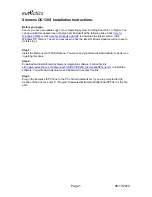
Working with file transfer and AIX
(If you work outside the AIX environment, you may skip this section, as the
information about working with file transfer does not pertain to the OS/390 or MVS,
VM, or VSE environments.)
ACIF needs to know two things about a file in order to print it:
How long is each print record
What kind of carriage control is used
As simple as this sounds, it is the source of most of the difficulty people have
printing with ACIF in an AIX environment.
ACIF processes print records. A record is a sequence of contiguous characters,
usually representing a printed line or a MO:DCA (AFPDS) structured field
2
. Each
record has a defined boundary or length. Some files contain information in each
record that describes the record's length; these are called variable-length files.
Other files require an external definition of length; these are called fixed-length files.
Variable-length files
Variable-length files may use a length prefix, which means they contain a
prefix that identifies the length of the record in the file. Each record
contains a field that gives the length of the record. If the record contains a
length, that length must be a prefix for each record and it must be a 16-bit
binary number that includes the length of the 2-byte length prefix. Use the
FILEFORMAT=RECORD control statement to identify files with length
prefixes.
Variable-length files may use a separator or delimiter to indicate the end of
a record, instead of using a length prefix. All of the bytes up to, but not
including, the delimiter are considered to be part of the record. For AIX, the
delimiter is X
'
0A
'
. If the file uses EBCDIC encoding, the newline character
is X
'
25
'
. Use the FILEFORMAT=STREAM control statement to designate
files that use newlines to indicate record boundaries.
ACIF reads the first six bytes and tests for all ASCII characters
3
, to
determine if a file is encoded in ASCII or EBCDIC. If no non-ASCII
characters are found, ACIF assumes the file uses the ASCII newline
character, X
'
0A
'
. Otherwise, ACIF assumes the file uses the EBCDIC
newline character, X
'
25
'
. Because an input file can misguide ACIF, either
intentionally or by accident, a set of rules has been established to
determine how ACIF will interpret how a file will be processed. The
following combinations are possible:
Data Type
Newline Character
All EBCDIC
EBCDIC X
'
25
'
All EBCDIC
ASCII X
'
0A
'
(Note 1)
All ASCII
EBCDIC X
'
25
'
(Note 1)
All ASCII
ASCII X
'
0A
'
2
Structured fields are similar to print commands.
3
code points from X
'
00
'
to X
'
7F
'
180
ACIF User’s Guide
Summary of Contents for S544-5285-01
Page 1: ...IBM Print Services Facility IBM AFP Conversion and Indexing Facility User s Guide S544 5285 01...
Page 2: ......
Page 3: ...IBM Print Services Facility IBM AFP Conversion and Indexing Facility User s Guide S544 5285 01...
Page 10: ...viii ACIF User s Guide...
Page 22: ...2 ACIF User s Guide...
Page 40: ...20 ACIF User s Guide...
Page 41: ...Part 2 Using ACIF in the AIX Environment Copyright IBM Corp 1993 1999 21...
Page 42: ...22 ACIF User s Guide...
Page 72: ...52 ACIF User s Guide...
Page 96: ...76 ACIF User s Guide...
Page 99: ...Part 3 Using ACIF in the OS 390 MVS VM and VSE Environments Copyright IBM Corp 1993 1999 79...
Page 100: ...80 ACIF User s Guide...
Page 106: ...86 ACIF User s Guide...
Page 134: ...Figure 24 Example of a Customer s Phone Bill 114 ACIF User s Guide...
Page 142: ...122 ACIF User s Guide...
Page 196: ...176 ACIF User s Guide...
Page 197: ...Part 4 Appendixes Copyright IBM Corp 1993 1999 177...
Page 198: ...178 ACIF User s Guide...
Page 206: ...186 ACIF User s Guide...
Page 210: ...190 ACIF User s Guide...
Page 226: ...206 ACIF User s Guide...
Page 253: ......
















































